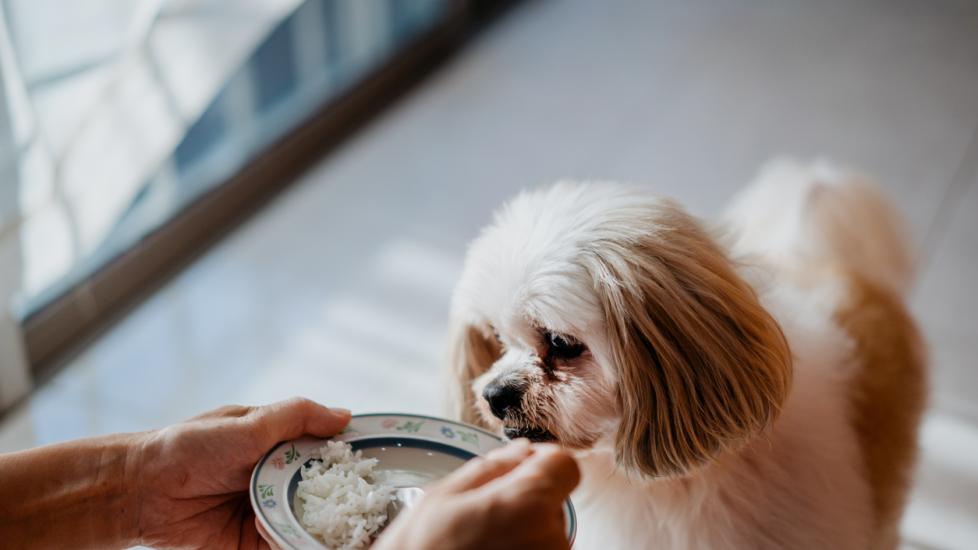Can Dogs Eat Rice?
iStock/hxyume
Chances are, you have a bag of rice in your pantry. Rice is a staple of many meals and can be used in a ton of different ways. But while we love it wrapped into our burritos or fried with eggs and veggies, is it safe to share with our pets? Specifically, can dogs eat rice?
Yes, dogs can safely eat rice. In fact, white rice is often recommended by veterinarians as bland food for dogs that are having gastrointestinal issues.
Is Rice Good for Dogs?
Rice is non-toxic to dogs, so it’s completely safe for them to eat when cooked. It’s also healthy, containing these vitamins and minerals:
-
Magnesium
-
Phosphorus
-
Manganese
-
Selenium
-
Iron
-
Vitamin B
-
Folic acid
-
Thiamin
-
Niacin
Can Dogs Eat White Rice?
White rice is not only safe for dogs, but it’s great for helping dogs with digestive problems, such as diarrhea, because:
-
It’s bland, which helps slow stool production and ease diarrhea
-
It has easily digestible carbohydrates
-
It contains fiber
-
Its starch helps bind your dog’s stool
Just be sure to not feed your pup too much white rice. It’s not meant to be a daily snack because it has a high glycemic index, meaning it can raise your pup’s blood sugar levels. This is especially concerning if your dog has diabetes or is obese. It’s best to feed your dog white rice only at your veterinarian’s recommendation.
Can Dogs Eat Brown Rice?
Brown rice is also safe for dogs to eat. It has a lower glycemic index than white rice and has more fiber. This helps keep your pup fuller for longer and helps alleviate constipation.
But brown rice is also harder for dogs to digest than its white counterpart. This is why brown rice is not usually recommended by veterinarians as a remedy for diarrhea.
Can Dogs Eat Jasmine Rice?
Jasmine and basmati are two types of long-grain white rice. The length of the grain doesn’t matter—like other types of white rice, jasmine and basmati are both safe for your dog to snack on.
How To Safely Feed Your Dog Rice
Your veterinarian will give you guidance on feeding your dog rice to help with GI issues. In general, make sure the rice is fully cooked and completely plain.
It’s best to cook the rice completely plain because some common rice additives, like butter, can seriously harm your dog’s health. You can, however, add a little bit of boiled boneless, skinless chicken or turkey to the rice.
If you are feeding your dog rice to help with ongoing digestive problems, make sure to use a 2:1 rice-to-protein ratio, as the rice is what helps bind your dog’s stool in the case of diarrhea.
How Much Rice Can a Dog Eat?
Keep rice portions small and in moderation. Treats and snacks of any kind should only make up 10% of your dog’s diet. The other 90% should come from a well-balanced dog food diet.
Rice as a treat should only be given to your dog up to two or three times per week, unless otherwise directed by your veterinarian for medical reasons. Follow the portions below:
-
Extra-small dog (2–20 pounds) = 1–2 tablespoons
-
Examples: Yorkies, Chihuahuas, Pomeranians, Pugs
-
-
Small dog (21–30 pounds) = 2–3 tablespoons
-
Examples: Basenjis, Beagles, Miniature American Shepherds
-
-
Medium dog (31–50 pounds) = ¼ cup
-
Examples: Basset Hounds, Border Collies, Australian Cattle Dogs
-
-
Large dog (51–90 pounds) = ⅓ cup
-
Examples: Pit Bulls, German Shepherds, Labrador Retrievers, Australian Shepherds
-
-
Extra-large dog (91+ pounds) = ½ cup
-
Examples: Newfoundlands, Bernese Mountain Dogs, Saint Bernards, Great Pyrenees
-
